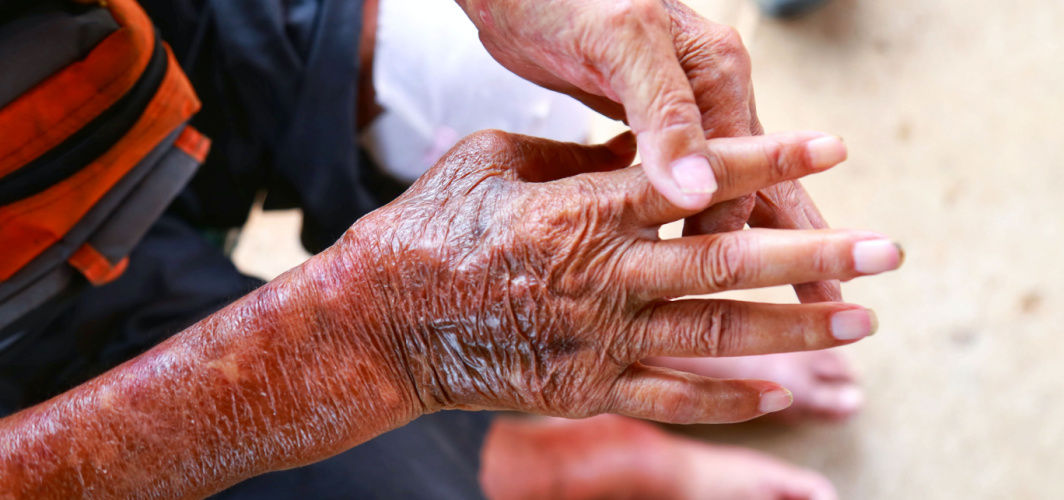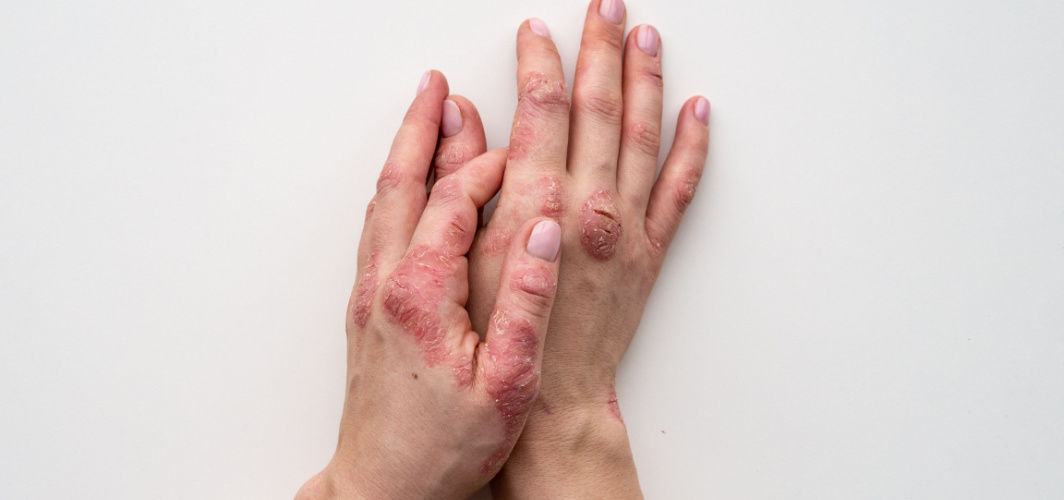Skin Care
Scleroderma: Definition, Causes, Triggers, Symptoms, Treatments & Prevention
9 min read
By Apollo 24|7, Published on - 06 October 2023
Share this article
0
0 like

Scleroderma, also known as systemic sclerosis or systemic scleroderma, is a chronic autoimmune disease that affects the connective tissues in the body. It is characterised by excessive production of collagen, a protein that gives structure to the skin and internal organs. This overproduction leads to thickening and hardening of the skin and tissues, causing a range of symptoms and complications. In this blog, we will offer a comprehensive understanding of Scleroderma, including its underlying causes, potential triggers, symptoms, available treatments, and effective prevention strategies, to empower you with knowledge about this challenging autoimmune condition.
Types of Scleroderma
There are two main types of Scleroderma, each with distinct characteristics:
1. Localised Scleroderma
Localised Scleroderma primarily affects the skin and underlying tissues, with limited or no involvement of internal organs. It is generally considered less severe than systemic Scleroderma. There are two types of localised scleroderma:
- Morphea: It is a type of localised Scleroderma characterised by oval or circular-shaped patches of thickened skin. These patches are typically purplish or reddish in the centre with a lighter, hardened border. Morphea patches are usually painless and may range in size from a few centimetres to several inches in diameter.
- Linear Scleroderma: It primarily affects a line or band of skin, often appearing as a single line down an arm or leg. This type of localised Scleroderma can also involve the deeper tissues, muscles, and, in some cases, bone.
2. Systemic Scleroderma
Systemic Scleroderma, also known as systemic sclerosis, is a more extensive and potentially severe form of the disease. It can affect not only the skin but also various internal organs and systems. There are two types of systemic scleroderma:
- Limited Cutaneous Systemic Scleroderma: It typically involves the skin of the fingers, face, and lower arms, often characterised by thickening and tightness. Internal organ involvement is less common and tends to be milder than in diffuse cutaneous systemic Scleroderma.
- Diffuse Cutaneous Systemic Scleroderma: It affects a larger area of the skin, often spreading rapidly and involving the arms, legs, trunk, and sometimes the face. Diffuse cutaneous systemic Scleroderma can have a more profound impact on a person's quality of life due to its systemic nature.
Causes and Triggers of Scleroderma
In this section, we will delve into the causes and triggers of Scleroderma.
1. Genetic Factors and Family History
Research suggests that genetics play a role in the development of scleroderma. Individuals with a family history of autoimmune diseases, including scleroderma, may be at a higher risk.
Some genetic mutations have been associated with an increased susceptibility to scleroderma. For example, certain variations in genes like HLA-DQA1 and HLA-DRB1 have been linked to the condition.
2. Environmental Factors
Here are some environmental factors that can play a role in the development of scleroderma:
- Exposure to Silica or Organic Solvents: Occupational exposure to certain environmental factors, such as silica dust or organic solvents used in industrial settings, has been studied as potential triggers for scleroderma. These exposures can lead to inflammation and fibrosis in the skin and internal organs.
- Certain Medications: Some medications, particularly those used in cancer chemotherapy, have been associated with triggering scleroderma-like symptoms. However, this is a rare occurrence, and the benefits of these medications often outweigh the risks.
- Autoimmune Dysfunction: In autoimmune diseases, the immune system mistakenly attacks healthy tissues, including the skin, blood vessels, and internal organs. Abnormalities in the immune system, such as an overproduction of collagen and abnormal functioning of immune cells, are believed to contribute to the excessive collagen production and tissue damage seen in scleroderma.
Symptoms and Diagnosis of Scleroderma
In this section, we will delve into the symptoms and diagnosis of Scleroderma.
1. Potential Symptoms of Scleroderma
Some symptoms of scleroderma include:
- Early Signs and Symptoms: Many individuals with scleroderma experience unexplained fatigue, which can significantly impact their quality of life. Joint pain and stiffness, similar to symptoms of arthritis, can be early indicators of scleroderma.
- Skin Changes and Raynaud's Phenomenon: One of the hallmark symptoms of scleroderma is skin thickening and hardening. It often begins in the fingers and can spread to other areas of the body. Raynaud's phenomenon, characterised by colour changes in the fingers and toes (usually white, blue, and then red) in response to cold or stress, is common in scleroderma patients.
- Gastrointestinal Symptoms: Scleroderma can affect the lower oesophagal sphincter, leading to acid reflux symptoms such as heartburn and regurgitation.
- Pulmonary Complications and Breathing Difficulties: Scleroderma-associated ILD can result in shortness of breath, a persistent dry cough, and reduced lung function. Some individuals with scleroderma develop pulmonary hypertension, which can lead to further breathing difficulties.
- Cardiac-related Symptoms: Scleroderma can affect the heart's electrical system, leading to irregular heartbeats (arrhythmias). Inflammation of the lining around the heart (pericardium) can cause chest pain and discomfort.
- Kidney Problems: Although relatively rare, scleroderma can lead to a sudden and severe increase in blood pressure known as a renal crisis, which requires immediate medical attention. Kidney problems may manifest as proteinuria (excess protein in the urine) and decreased kidney function.
2. Diagnosing Scleroderma
The diagnostic process aims to identify characteristic clinical features, assess the extent of organ involvement, and rule out other conditions with similar symptoms.
- Physical Examination: Doctors will perform a thorough physical examination to assess skin changes, joint involvement, and organ function.
- Blood Tests: Blood tests may reveal specific autoantibodies associated with scleroderma, such as anti-centromere or anti-Scl-70 antibodies.
- Imaging: Imaging studies like chest X-rays or high-resolution CT scans can detect lung and heart involvement.
Treatment Options for Scleroderma
In this section, we will delve into some treatment options for Scleroderma.
1. Medications for Managing Symptoms and Slowing Disease Progression
While there is no cure for scleroderma, various medications are used to address specific symptoms and to slow down the progression of the disease. Treatment plans are tailored to the individual's symptoms, the extent of organ involvement, and overall health. Here are some common medications used in the management of scleroderma:
- Immunosuppressive medications, such as methotrexate or mycophenolate mofetil, may be prescribed to suppress the immune system's abnormal response, reduce inflammation, and slow the progression of scleroderma.
- Medications like calcium channel blockers (e.g., nifedipine) can help dilate blood vessels, relieving symptoms of Raynaud's phenomenon, which is common in scleroderma.
- Proton pump inhibitors (PPIs) and H2-receptor antagonists can manage acid reflux and gastroesophageal reflux disease (GERD). For pulmonary complications, including interstitial lung disease (ILD), doctors may prescribe corticosteroids, immunosuppressants, or antifibrotic medications, such as nintedanib.
2. Physical Therapy and Occupational Therapy
Physical and occupational therapy play crucial roles in managing scleroderma-related joint pain, stiffness, and limited mobility. Physical therapists can design exercise programs to maintain joint flexibility and muscle strength.
Occupational therapists can assist with adaptive techniques and devices to improve daily living activities.
3. Pulmonary Rehabilitation and Breathing Exercises
Pulmonary rehabilitation programs focus on improving lung function and stamina for those with pulmonary complications. Breathing exercises, such as deep breathing and diaphragmatic breathing, can help manage breathing difficulties.
4. Surgical Interventions for Specific Complications
Surgery may be necessary for certain complications. For instance, in severe cases of GERD or esophageal strictures, surgical interventions like fundoplication may be considered. In cases of severe Raynaud's phenomenon, sympathectomy surgery may be an option to improve blood flow.
5. Stem Cell Transplantation as a Potential Treatment
In some cases, particularly when scleroderma is severe and rapidly progressing, stem cell transplantation may be considered. This procedure aims to reset the immune system and halt disease progression. However, stem cell transplantation is a complex and high-risk procedure and is usually reserved for carefully selected patients in specialised centres.
Lifestyle Management and Preventive Measures
Living with Scleroderma involves not only medical treatments but also adopting a healthy lifestyle to manage symptoms and improve overall well-being.
1. Regular Exercise and Stretching
Exercise and stretching can help maintain joint flexibility, muscle strength, and overall mobility. Low-impact activities like walking, swimming, and gentle yoga are often recommended.
Consult with a physical therapist for a tailored exercise plan that suits your abilities and needs.
2. Proper Skin Care and Protection from UV Rays
Since scleroderma can make the skin more sensitive, it's crucial to protect it from excessive sun exposure. Use sunscreen with a high SPF, wear protective clothing, and avoid prolonged sun exposure to prevent skin damage.
3. Quitting Smoking and Avoiding Second-hand Smoke
Smoking can worsen the symptoms of scleroderma and increase the risk of vascular complications. Quitting smoking and avoiding second-hand smoke exposure are essential for managing the disease.
4. Balanced Diet and Healthy Eating Habits
A well-balanced diet can support overall health and help manage specific symptoms.
- Consume a variety of fruits, vegetables, whole grains, and lean proteins (such as poultry, fish, beans, and tofu) to provide essential nutrients and promote overall well-being.
- Limit processed foods and high-fat foods as these can exacerbate symptoms and negatively affect overall health.
Coping with Scleroderma: Support Groups and Resources
Coping with Scleroderma can be challenging, both physically and emotionally. Support groups and informational resources can play a crucial role in helping individuals and their families navigate the complexities of the disease.
1. Importance of Emotional Support
Emotional support is vital for individuals with Scleroderma as it can help reduce feelings of isolation, anxiety, and depression that often accompany chronic illnesses. Sharing experiences with others who understand what you're going through can provide comfort and validation.
2. Connecting with Local Support Groups
Many communities have local Scleroderma support groups where individuals and their families can meet face-to-face to share experiences, exchange information, and provide emotional support.
These groups often organise events, guest speakers, and educational sessions to help members better understand the disease.
3. Online Resources and Informational Websites
Numerous online resources and informational websites are dedicated to Scleroderma, offering a wealth of information, articles, and forums for discussion. These platforms allow individuals to connect with a broader Scleroderma community, even if there are no local support groups available.
Conclusion
In conclusion, Scleroderma is a challenging autoimmune condition characterised by skin thickening, but its impact extends far beyond the surface. While its exact causes remain elusive, genetic predisposition, environmental triggers, and immune system abnormalities all contribute to its development. With early diagnosis, informed care, and a supportive network, individuals with Scleroderma can navigate their journey with resilience and the confidence that they are not alone in their battle against this complex condition.
Skin Care
Consult Top Dermatologists
View AllFrequently Asked Questions
What are the risk factors for Scleroderma?
What are the risk factors for Scleroderma?
Can Scleroderma cause lung problems, and how are they treated?
Can Scleroderma cause lung problems, and how are they treated?
Is there a connection between Scleroderma and cancer?
Is there a connection between Scleroderma and cancer?
Are there any special considerations for managing Scleroderma during pregnancy?
Are there any special considerations for managing Scleroderma during pregnancy?
Is there a cure for Scleroderma?
Is there a cure for Scleroderma?
Leave Comment
Recommended for you

Skin Care
Psoriasis: Definition, Causes, Symptoms, Treatments & Prevention
Discover Psoriasis - its definition, causes, symptoms, treatments, and prevention strategies for comprehensive insights and effective management.

Skin Care
6 Scientifically Proven Home Remedies For Removing Skin Tan
This article provides remedies for fading an unwanted tan with exfoliation using natural ingredients. These remedies can help reduce the appearance of a tan by eliminating dead skin cells and reducing pigmentation, but it's important to use them cautiously.

Skin Care
Which Face Serum To Choose? Know The Ingredients & Their Health Benefits
Face serums are concentrated formulas with antioxidants, vitamins and other active ingredients that are designed to penetrate deep into the skin and repair the damage. Know the ingredients to understand which face serum will suit your purpose.
Subscribe
Sign up for our free Health Library Daily Newsletter
Get doctor-approved health tips, news, and more.
Recommended for you

Skin Care
Psoriasis: Definition, Causes, Symptoms, Treatments & Prevention
Discover Psoriasis - its definition, causes, symptoms, treatments, and prevention strategies for comprehensive insights and effective management.

Skin Care
6 Scientifically Proven Home Remedies For Removing Skin Tan
This article provides remedies for fading an unwanted tan with exfoliation using natural ingredients. These remedies can help reduce the appearance of a tan by eliminating dead skin cells and reducing pigmentation, but it's important to use them cautiously.

Skin Care
Which Face Serum To Choose? Know The Ingredients & Their Health Benefits
Face serums are concentrated formulas with antioxidants, vitamins and other active ingredients that are designed to penetrate deep into the skin and repair the damage. Know the ingredients to understand which face serum will suit your purpose.
